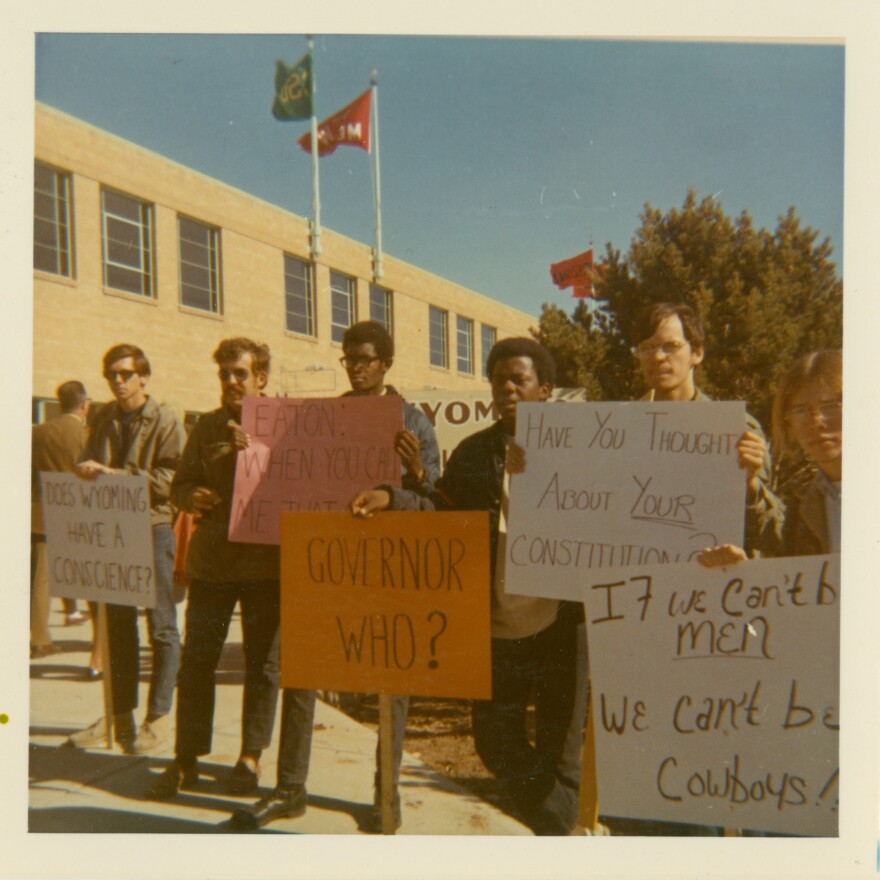Racial diversity is not one of the things for which Wyoming is best known. According to census data, only one-point-five percent of the state’s population is African American. Now, a class at the University of Wyoming is documenting the largely untold history of black people in the West. The class is confronting black invisibility—real and perceived.
Kerry Pimblott teaches the Black West class in UW’s African American and Diaspora Studies department. She says Wyoming’s apparent racial homogeneity disguises a more complex reality. “Part of it for me is to recover the contributions of African Americans and people of African descent to the state of Wyoming, because they’ve always been here and they’ve always contributed. Their history has been erased.”
Or, perhaps never told at all. A recent ranking by the Southern Poverty Law Center’s Teaching Tolerance project puts Wyoming and four other states at the bottom for not adequately addressing the history of race and diversity in public schools. That’s largely because the state doesn’t require students to learn civil rights history.
But for Pimblott, only part of what she calls black invisibility happens in the classroom. “The erasure of black people from the state is both at the historical level, in terms of how we’ve studied and learned about our history, but it’s also the actual erasure by the exclusion of people from the state, through racist policies and practices.”
By the 1910’s, Pimblott says vigilante justice was in decline, except when it came to African Americans. Wyoming had some of the most lynchings of African Americans per-capita in the country. And discriminatory public policies made Wyoming inhospitable to African Americans: enslavement was a risk in the territory’s early years; interracial marriage was illegal until the 1950s. [Correction: Wyoming's Anti Miscegenation Law wasn't repealed until 1965.]

This is not say the West didn’t offer opportunities. Life in the Old West was a delicate balance between hardship and reward, and Pimblott says African Americans were a visible part of Wyoming history at every turn: as soldiers, railroad workers, homesteaders, legislators. “Their experience was a complicated one that had opportunities but also had obstacles.”
Caanan Hurst and two of his classmates are working on a documentary for the Black West class. They’re exploring present day experiences of African Americans at the University of Wyoming. What they’ve found has been surprising. “Even overt racism, which people think is so done with: I’m hearing stories from a month ago, a year ago, two years ago that are just blatantly racist. And so with this documentary, showing real life stories of people saying ‘Yeah, this is what I’ve experienced here in Wyoming,’ that makes it real, that hits close to home with people,” says Hurst.
Hurst’s classmate Natawsha Mitchell is working on the documentary, too. She’s bi-racial. Growing up in a white family in Torrington, she was the only black student in school until her junior year. She didn’t sit next to another black student in class until college. And it was in college Mitchell started to realize some of what she had written off as playground teasing was actually racism. “I think as a kid I had never framed it that way because it wasn’t talked about that way.”
Now that she’s equipped to recognize discrimination, Mitchell sees racist attitudes every day. She’s one of fewer than 100 black students at UW, and sometimes that attracts attention. One day, a woman approached her in the bookstore “and said, ‘I just have to ask, where are you from?’ And I said I grew up in Torrington. ‘Oh, I just had to ask, because we don’t have very many African women on this campus.' And then was just, like, ‘Bye.’”

Mitchell says, as an African American, she’s been accused of cheating for taking black history classes. She says she goes to the Cowboys’ football games and hears the N-word thrown around. “Just yesterday, a lady told me if I was unhappy with the campus climate as a racial minority, I should just go to another school.” She says all of this, over time, has a corrosive effect on her self-esteem and how comfortable she feels on campus.
So in the face of this experience, Mitchell says it’s been exciting to discover there is black history in seemingly white Wyoming. That’s the point of the Black West class. On Tuesday, April 29 Kerry Pimblott’s students will display their findings to the public through the documentary film, art, and museum-style exhibits. Challenging Invisibility: Stories of Black Life in the West takes place from 12:15 to 1:15 pm at the Wyoming Union West Ballroom at UW.
Pimblott says, “The goal is to translate to the public here in Wyoming a sense of the centrality of African Americans’ contributions, to recover those experiences, and maybe to revise some of the dominant narratives we have about our own sense of space and place in Wyoming.”
Her ultimate aim is to offer materials from the class to public school teachers, so the K through 12 curriculum can offer a more complete view of Wyoming’s history.



